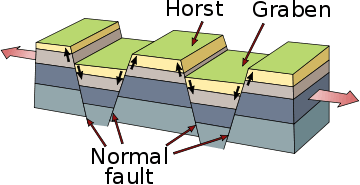Horst (geology)

In physical geography and geology, a horst is the raised fault block bounded by normal faults or graben.[1] A horst is a raised block of the Earth's crust that has lifted, or has remained stationary, while the land on either side has subsided. Horst is Dutch and German for heap.
The Vosges Mountains in France and Black Forest in Germany are examples of horsts, as are the Table, Jura and the Dole mountains. The word is also applied to larger areas, such as the Russian Plain, Arabia, India and Central South Africa, where the continent remains stable, with horizontal table-land stratification, in distinction to folded regions such as the Eurasian chains.
Horsts and hydrocarbon exploration
In many rift basins around the world, the vast majority of discovered hydrocarbons are found in conventional traps associated with horsts. For example, much of the petroleum found in the Sirte Basin, Libya (of the order of tens of billions of barrels of reserves) are found on large horst blocks such as the Zelten Platform and the Dahra Platform and on smaller horsts such as the Gialo High and the Bu-Attifel Ridge.
See also
| Look up horst in Wiktionary, the free dictionary. |
References
- ↑ Fossen H. Structural Geology. Cambridge University Press. p. 154. ISBN 9781139488617.
 This article incorporates text from a publication now in the public domain: Chisholm, Hugh, ed. (1911). "article name needed". Encyclopædia Britannica (11th ed.). Cambridge University Press.
This article incorporates text from a publication now in the public domain: Chisholm, Hugh, ed. (1911). "article name needed". Encyclopædia Britannica (11th ed.). Cambridge University Press.